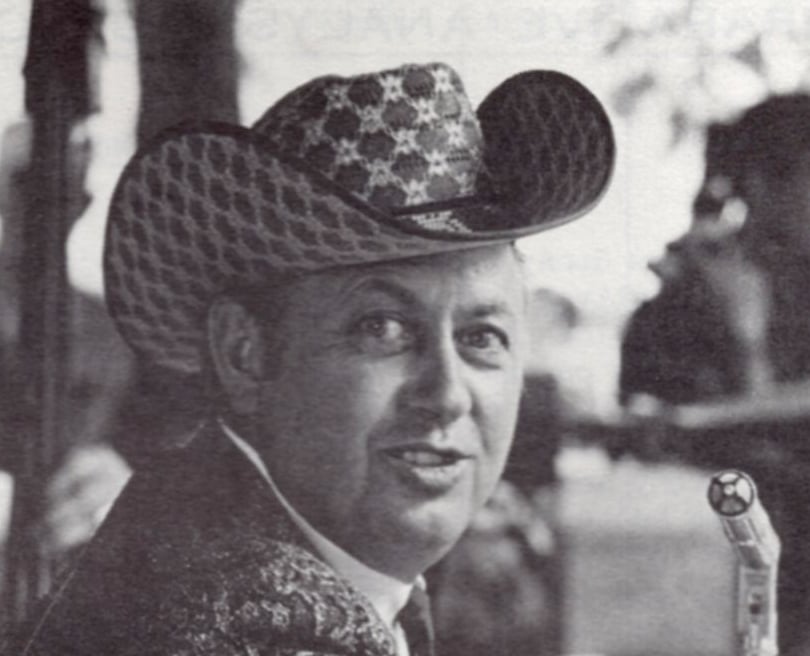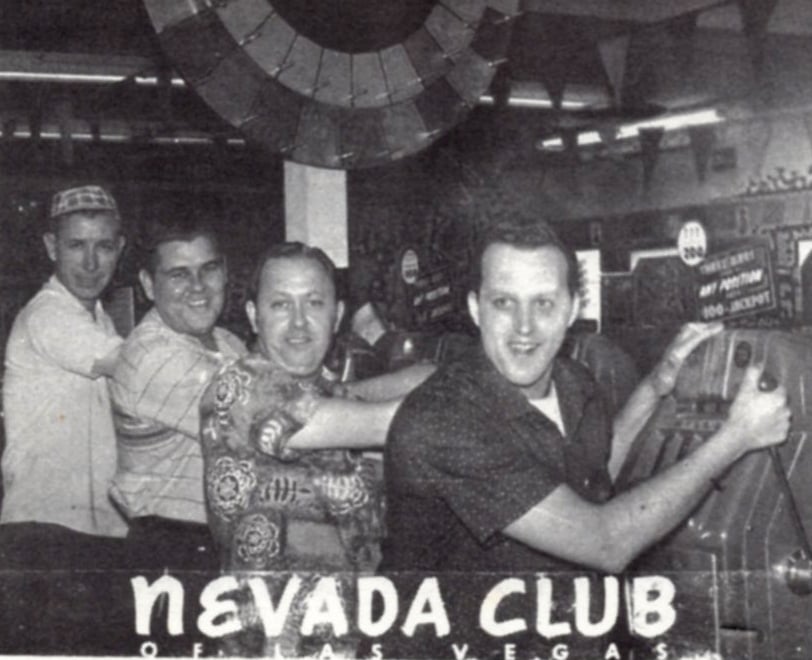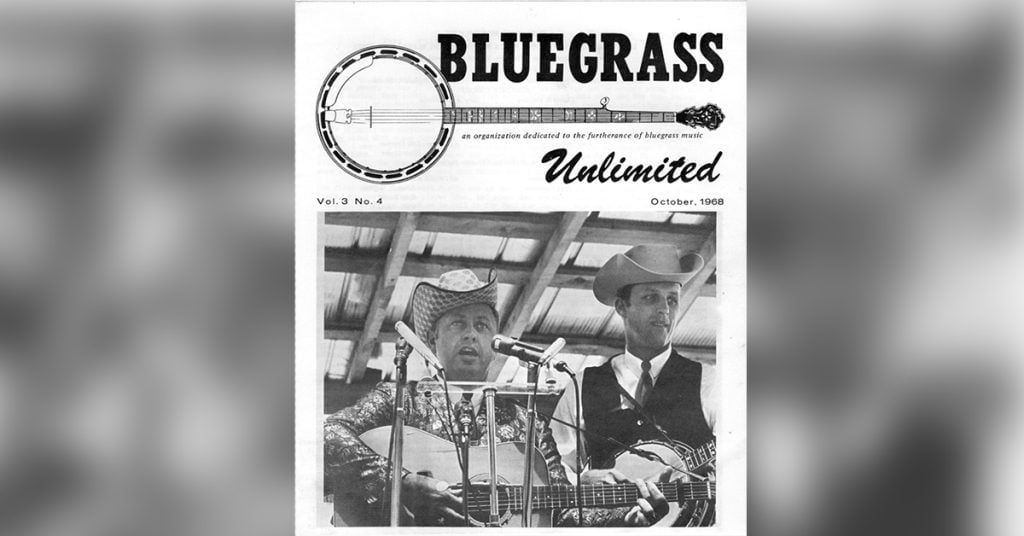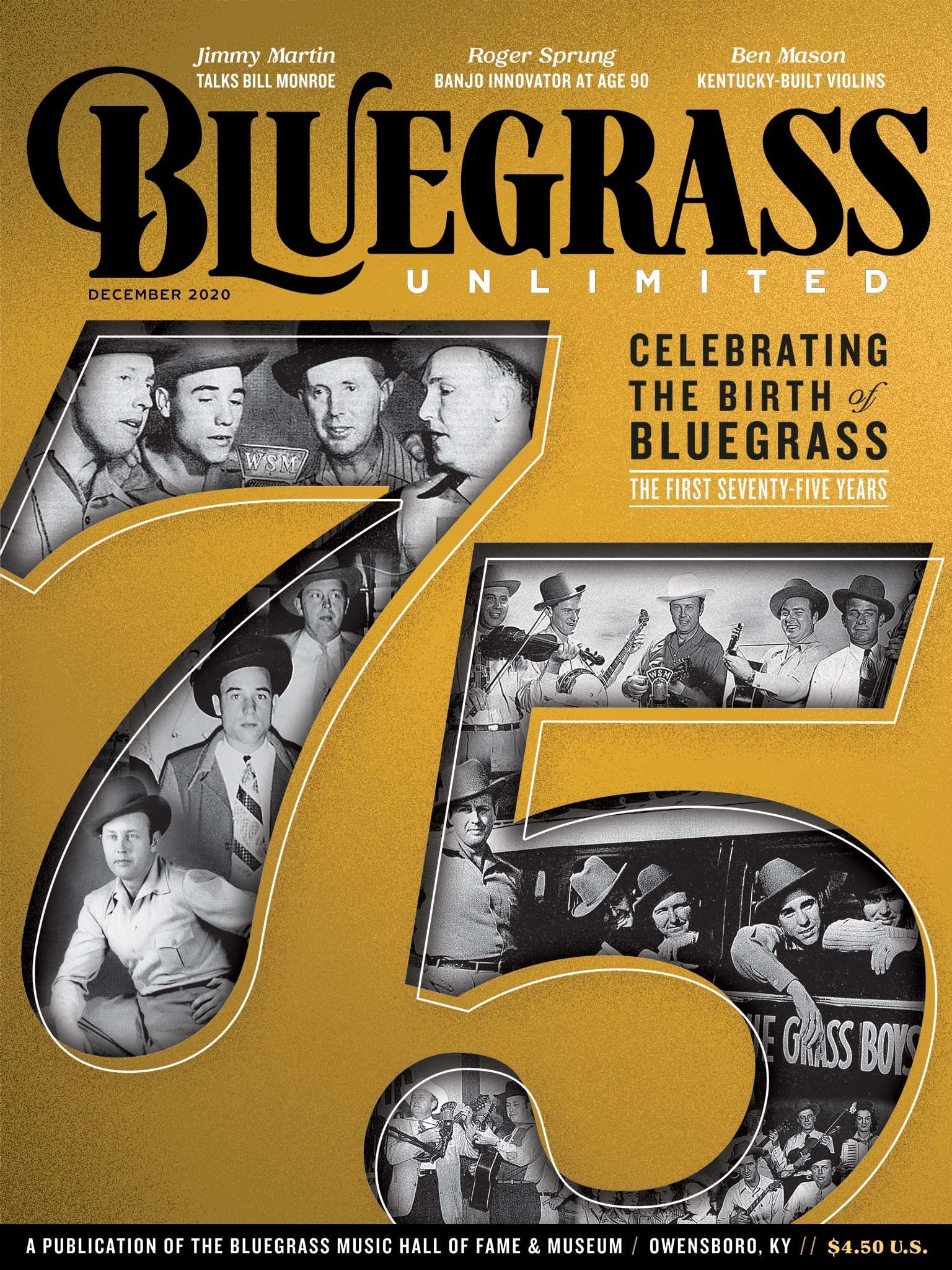Home > Articles > The Archives > On the Road with Jimmy Martin
On the Road with Jimmy Martin
Reprinted from Bluegrass Unlimited Magazine
October, 1968 — Volume 3, Number 4
Jimmy Martin is one of the most colorful and controversial artists in bluegrass music today. Over the years, he has produced some great bluegrass recordings and he stands among the giants of the music. Very little has been written accurately about this man, and for this reason he is widely misunderstood. I would like to pass on to you my personal knowledge of and experiences with this colorful entertainer.
I was a member of Jimmy Martin’s group (known as the SunnyMountain Boys) for a period of two years, or so. During that time, I traveled thousands of miles and performed under almost every conceivable condition. I recorded over thirty sides with Jimmy for Decca records and appeared many timeson network television and radio. I was 23 years old and had been playing a banjo since I was sixteen when I joined Jimmy’sband. I had already played for years with such groups as Red Allen, Buzz Busby,Bill Harrell, The Stoneman Family, The Yates Brothers and the Country Gentlemen, but I learned more in my two years on the road with Martin than I did in all the rest of the time put together.
The first time I played with Martin was in the winter of 1961 inNewark, New Jersey. Paul Craft, who was his banjo player then, had mumps and couldn’t make the trip from Wheeling. Jimmy called me and asked me to fill in for Paul for the two days in Newark. We played two nights at a club and stayed over in Mount Vernon, New Jersey with Jim’s Fan Club president.
After playing an awful lot of stuff while sitting around during the day, Jimmy asked me if I would like to work for him when and if Paul Craft should leave. I remember Paul Williams tellingme that Jimmy liked the way I played his tunes and that he wanted me to join his group. After about a month I moved to Wheeling and became a Sunny Mountain Boy. Jimmy helped me move all my stuff from Washington, D. C. to Wheeling in a U-Haul trailer behind his Cadillac.
Jimmy eats, sleeps, lives and breathes bluegrass music and he talked it to me in a steady stream. He can’t actually play a banjo, but he can fake it through with two fingers enough to show you what he wants. In a couple of weeks he had me playing stuff I hadn’t even thought about before.
Jimmy had Paul Williams playing mandolin and singing tenor with him at the time. Paul had played guitar with the Lonesome Pine Fiddlers and told me he only knew a few chords on a mandolin when he joined Jimmy’s group. They found that old F-4 you’ve heard on Decca so many times in a pawn shop in Nashville for $35 and, before long Jimmy had Paul playing the style he wanted on it. Jimmy himself is a fine mandolin player.

One of the first tours we worked was a two week stand at the Golden Nugget in Las Vegas. We drove the distance in Jimmy’s’59 Cadillac—all six of us, all 2,000 miles of the way. I don’t think I’ll ever forget that trip. There was Jimmy, Paul and I, Jeb Collins (comedian and bass player), Kirk Hansard (drummer and bass singer) and his wife, Lois Johnson, all jammed inside with numerous suitcases, hat bags, and shaving kits. In the trunk were three guitars, an amplifier, drum, mandolin, banjo, more suitcases, more shaving kits andall our clothes for three weeks. On top was Jeb’s bass fiddle tied on with an assortment of dog leashes, clothes rope and rotten straps from the carrier. When we filled up the gas tank, the back bumper was almost touching the ground. I remember Jimmy telling me to take it easy on the bumps and to take off from traffic lights very gently lest we break an axle.It took us two days and a night to get to Vegas. We had two blowouts and burned a valve in the Caddie on the way.
The people in Vegas were very hospitable and told us ours was the first bluegrass music they’d heard out there. At the Nugget there is continuous entertainment from 2 p.m. until 5 a.m. so we worked six or seven shows every day. They had two or three other acts in there with us.
One was a Tahitian drum band with grass skirts and all. Bob Wills and his Texas Playboys were there too, I believe. There was a place across the street called the Mint Lounge and Tex Williams was playing there. I remember watching him put $150 in the silver dollar slot machine one night. Jimmy played a lot too. He must have lost $50 or $60, but to this day maintains he won that much.
We stayed at a good motel with a pool and other conveniences. They gave Jimmy, Paul, Jeb and I an apartment style room with a kitchen in it. The first thing Jimmy did was race down to the grocery and get a big bag of soup beans andcorn bread mix. Gene Vincent and his band (you know, “Blue Suede Shoes”) was staying in the motel too. You should have seen the expression on his face when Jimmy invited him up to dinner. Jimmy explained that we were from the country and weren’t ashamed of it.
The trip back was just as enjoyable and we made it back to Wheeling just in time to do the show at the WWVA Jamboree. During the time we were at Wheeling we averaged six days per week on the road. We played in Canada, California, Florida and a lot of other places in between. I remember going three days one time without taking off my shoes.
In the summer of 1962, we cut a gospel album and some songs for Decca. The album came out a year or so later and most of the songs are out on singles. The songs were recorded at Bradley (now Columbia) Studios in Nashville on three consecutive days:
MASTER NO. LP Release Number
August 29, 1962, afternoon
112,553 Lord I’m Coming Home DL 4360
112,554 Goodbye DL 4360
112,555 Pray the Clouds Away DL 4360
112,556 Give me the Roses Now DL 4360
112,557 Prayer Bells of Heaven DL 4360
August 30, 1962, morning
112,558 Give Me Your Hand DL 4360
112,559 Stormy Waters unreleased
112,560 What Would You Give in Exchange DL 4360
112,561 Shut-In’s Prayer DL 4360
112,562 A Beautiful Life unreleased
112,563 Little White Church DL4360
August 31, 1962, 2:00 pm
112,585 The Old Man’s Drunk Again DL 4536
112,585 Moonshine Hollow unreleased
112,585 Hey Lonesome DL 4536
112,585 Tennessee DL 4996
Personnel:
Jimmy Martin Rhythm Guitar, Vocal Lead
Paul Williams Mandolin, Vocal Tenor
Bill Emerson Banjo, Vocal Baritone
Poss. Joe Jenkins Bass
Poss. Willie Ackerman DrumsKirk HansardVocal BassLois JohnsonVocal Alto
While we were in Nashville Jimmy was hot to trot. He was in and out of record companies, publishers, promoters and bookers offices all week. I was fortunate enough to be with him and met many people who later became my friends. We also played the Grand Ole Opry that week. It was at this time that Jimmy decided to move to Nashville in order to be closer to the heart of the music business. We stayed at the James Robertson hotel and Paul and I discovered a little place aroundthe corner that sold hamburgers as big as a 45 rpm record. Paul had a big appetite and could eat five of them at one time.
About this time, we felt we were really starting to work welltogether. We had a great quartet, trio and duet sound and had developed some different approaches on the banjo and mandolin. Jimmy told us that we were the best group he’d ever had and everyone else seemed to think so too. Jimmy was very relaxed on stage and we brought the audience to its feet everywhere we played.
Jimmy always went out of his way to do what he considered good for us all; but he is rather high strung, and as leader he insists that things be done his way. We had a couple of fellowsin the band from time to time who weren’t able to comprehend and adjust accordingly. Jimmy wanted his musicians to play his stuff. He didn’t figure he needed a banjo player that played like Earl, Ralph or Don, or a mandolin player who tried to copy Bill Monroe or Jesse McReynolds. He just wanted a man to play the songs the way he was singing them. That is certainly his right as an employer.
Being part of a traveling road show is a hard life at best. Jimmy always tried to stay at the best motels and go first classas much as time would allow. In December 1963, Jimmy signed a contract with the Bob Neal booking agency in Nashville and decided upon very short notice to more there from Wheeling. I realized that the distances we would be travelling would be doubled since most of Jimmy’s work was inthe eastern and New England states. It was mainly for this reason that I decided to return home to Washington and teamup with Red Allen and the Yates Brothers once more.
Jimmy has always been fair and honest with me. I have learned a great deal from him and I feel I have contributed a lot to his music in return.
(To Be Continued)
On the Road with Jimmy Martin Part II
Reprinted from Bluegrass Unlimited Magazine
November, 1968 — Volume 3, Number 5
I remained in D. C. as a member of the Kentuckians (Bill Emerson—Red Allen—The Yates Brothers) until June, 1965- Jimmy had a couple of hit records out about this time. The firstone, “Widowmaker”, reached number six on the national charts, and “Sunny Side Of The Mountain” was up around number eighteen. Jimmy had asked me many times to rejoin him and made several very generous offers to me. He also promised that if I returned, he would put my name on all his records as featured on the 5-string banjo. I felt that this was the best thing for me at that time and rejoined the group in June, 1965. My old friend Earl Taylor also rejoined about this time. Vernon Derrick, a really fine musician was already in the band.
One of the first shows we worked was at Sunset Park in Oxford, Pennsylvania. Mr. Waltman who owns and operates the park told us that he thought we were one of Jimmy’s best groups and he would like to see us all together the next year. But the next time we played Sunset Park, I was the only one still with Jimmy.

Jimmy never tried to hide anything, and if a banjo player asked him for a job he’d have him audition right on the spot. I imagine he thought it would keep us all on our toes and tryingout best if we thought he might be considering someone in our place. I personally never cared for this policy even though he told me it was more in fun than anything else. This type of thing has caused Jimmy to lose quite a few of his side men over the years. There were some amusing moments however.I recall one banjo player from up north who came back to our dressing room with his girlfriend, having privately asked Jimmy for a job earlier in the evening.
Jimmy handed him my banjo and had him try out right then and there. We were all watching him and I guess he got a littlenervous. He cut down on “Earl’s Breakdown” or something and before he got through the first few bars, Martin asked him“Don’t you know none of my tunes?” He said “Well, how about ‘Cripple Creek?’” By that time he was starting to get a little rattled.
My banjo got out of tune a little bit, and after he’d played a verse and a chorus, Martin reached over and took it right out of his hands. He handed it over to me and said “show him how it goes, man.” I think he gave up the idea of working for Jimmy Martin right then.
Traveling on the road is a difficult and dangerous life. In all themiles we travelled, we never had an accident. We were never allowed to drive faster than sixty miles per hour under any circumstances, and Jimmy was always strict with the drivers. We tried to take the driving in shifts, and we were all very serious about it. No one was allowed to get drowsy behind thewheel, and at night someone was always required to remain awake to talk to the driver. This was known as “riding shotgun.”
Nodding behind the wheel would usually result in not being spoken to for a day or so. We also engaged extensively in a practice known as “jungleing”. Instead of stopping at restaurants, we’d get a loaf of bread, some cheese, bologna, mustard, mayonnaise and milk, and find a picnic table beside the road somewhere. This practice usually resulted in much merriment and was always looked forward to. A trapeze artist at Idlewild Park told Jimmy that he kept fit by eating nothing but fruit and vegetables. From that time on we had to stop at least once a day at a roadside fruit stand. The car always smelled pleasantly of apples, pears, tomatoes and oranges.
Every time we played on a package show, the other acts would come wheeling up in big converted double decker buses and motor coaches. These busses were usually air-conditioned and had all the comforts of home: running water, beds, reclining seats, and plenty of space for belongings. You could also get up and walk around, play cards, practice your music and other things to break the monotony of a long trip. Buses like these are far safer than an automobile. Jimmy always assured us that buses were quite undesirable, and from his standpoint they probably were. But the band sufferedmany discomforts while traveling in automobiles. I spent many a night jammed into a comer of the back seat with my head up against a door handle or window crank. I am 6’2″ andweigh 200 pounds. Needless to say, I was never comfortable for more than a few hours in a crowded automobile.
Jimmy was a non-smoker and if anyone else smoked, he could expect a constant stream of invective directed against the use of tobacco. He tried several times to ban smoking in the car, though some continued in spite of the abuse and complaints. I am also a non-smoker and even though I do believe in individual rights, I must say it often got a little smoky in there. Ironically, Martin now travels in a bus and smokes a pipe.
In my opinion Martin is the best guitar player in bluegrass music. He is not a lead guitar man like Don Reno or Doc Watson; he is a bluegrass rhythm guitar player. As such, his function is to set the pace and provide background rhythm forhis group. In this capacity he is unsurpassed. I have played with many top rhythm men, but not one of them comes close to Martin. Anyone who has worked with him for any length of time at all will say the same thing. He sounds like he is doing three times as much as he looks like he is doing. His sense of timing and rhythm is uncanny. He is always coming up with some kind of run or stop that no one has ever heard before. Despite all this, I never saw him take his guitar out of its case unless he was getting ready to do a show. It all just comes to him naturally.
Jimmy always tried to get us to work together as a unit and dowhat he was doing on our own instruments. He would be vexed if we sat around playing anyone else’s songs. He would tell us to work on his songs, because they were what was paying us our living. Jimmy also demanded perfection on the stage; if you forgot how to start a song or something, you weren’t likely toforget the next time.
On July 8, 1965 we recorded another session at Columbia Studios in Nashville, five instrumentals and a vocal as follows:
MASTER NO. LP Release Number
NA 13663 The Last Song (L.E. White) 31846, DL74769
NA 13664 Sweet Dixie (Emerson) 31846, DL74769
NA 13665 Wild Indian (arr. Emerson, Martin 32201, DL74891
NA 13666 Run Boy Run (arr. Emerson, Martin) 31921, DL74769
NA 13667 Theme Time (Emerson-Williams) DL 74891
NA 13668 Orange Blossom Special (arr. Martin)* DL 74891
Personell:
Jimmy Martin Guitar
Bill Emersonq Banjo
Vernon Derrick Fiddle
Lightning Chance Bass
Earl Taylor Mandolin *harmonica
Willie Ackerman Drums
Harry Silverstein, Decca’s A & R man in Nashville thoughtthat this was a particularly good session, and especially liked “Sweet Dixie”. These instrumentals were going to be on an album at a later date but Harry wanted to release “Sweet Dixie” right away. It received a “Bulls-eye” in Cash Box when it was reviewed and went on to become one of Jimmy’s best-selling instrumentals.
We were also working on several other tunes about that time. These were also to go on the instrumental album. While we were staying with Red Spurlock (a fellow banjo player) in Fairborn, Ohio, I went through a lot of old titles he had up there and decided to work out some arrangements on “She’ll Be Coming Around The Mountain” and “You Are My Sunshine” among others. Vernon Derrick and I worked on the arrangements for some time. I never did get them to the recording studio, but Jimmy had another banjo player do them later on. I also recorded eight other sides with Martin:
Recorded December 22, 1965:
MASTER NO. LP Release Number
NA 13848 I Can’t Quit Cigarettes 31921, DL74769
NA 13849 Lost Highway DL74769
NA 13850 The Good Things (Outweigh the Bad) DL74769
Recorded January 10, 1966:
MASTER NO. LP Release Number
NA 13866 The Summer Is Gone 32031, DL74769
NA 13867 Fraulein DL74769
NA 13868 You’re Gonna Change DL74769
NA 13869 Tennessee Waltz DL74769
NA 13870 Little Maggie, She’s So Sweet DL 74891
The personnel on these recordings was the same as on the previous session with the exception of Earl Taylor who had been replaced by Bill Torbert. This last session was completely unrehearsed; done at the end of a three week road trip into Canada.
At this time I was running Jimmy’s show for him even to the point of collecting his money. I was responsible for the sale of all his records, pictures and song books. I was required to pay the band members their percentage for sales and to submit an accurate accounting to Martin at the endof every month.
It was also my responsibility to see that the car was properlyloaded and cared for. When Jimmy hired a new man, it fell upon me to teach him all the songsand duties that wererequired of him. If that particular man didn’t know his part in the quartet or left some records lying around, I was sure to be the first to hear about it. All during this time Jimmy was havingproblems with his wife, Barbara, whom he has since divorced, and this didn’t make life any easier.
I began to find that I wasn’t able to hold up under the strain ofall this and decided to giveup the road work for good. I also fell asleep at the wheel of my car on the way back fromFrontier Ranch in Columbus, ran down into the grassy center strip and dropped a front wheel into a concrete drain. It completely ruined my car, which I had beenvery fond of. This settled matters and I quit the road for good.
Many people have asked me how I liked working for Martin. I have replied in many ways usually depending upon the mood I was in. I enjoyed working for Jimmy Martin very much. He has always been a close friend and treated me with respect. I gained a world of experience as a member of his group and met many people who otherwise would be strangers to me.
I have heard many people remark that Jimmy brags and talks too much. Others say it is impossible to talk to him because the only part of the conversation that interests him is what he is saying. This is only partly true. Jimmy Martin is very high strung. He only possesses an elementary education. Whenever something good has happened to him such as a good selling record or an award of some kind, he is very anxious to tell everyone about it. What is actually exuberance is often mistaken for brash conceit.
Jimmy is very excitable. When he gets around a group of othermusicians he doesn’t exactly act himself. Underneath he is a very sensitive person. Whenever he hears something derogatory about himself it upsets him greatly. In one of the first issues of Bluegrass Unlimited there was an account of his appearance at the 1966 Warrenton, Virginia Bluegrass Festival which was both derogatory and unnecessary. Since that time Martin has refused to cooperate with anyone from this magazine. One can count the truly great bluegrass artists on the fingers of one hand and Jimmy Martin is certainly a member of this select group.
I am sure that the readers of BU would like to hear more about him. In my opinion he is a great entertainer, fine musician and good man, and I, for one, would like to see moreof him in these pages.
Ed. Note. The master numbers for the songs recorded on August 31, 1962 should read as follows THE OLD MAN’S DRUNK AGAIN 112,585, MOONSHINE HOLLOW 112,586, HEY LONESOME 112,587, TENNESSEE 112,588. There is a correction in the date that Martin decided to move to Nashville. This should read December, 196

